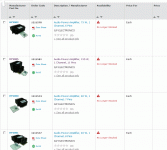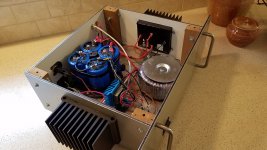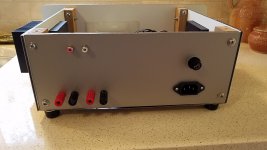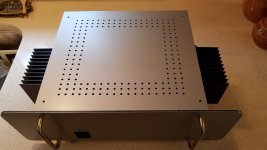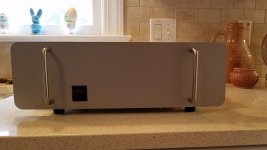ILP were first class engineers greatly held back by the format. Impossible to adjust. No breathing room for the capacitors. Apart from that very nicely thought out with a beautiful extrusion. Not cheap to do. Myself I would have made them AC coupled with external capacitor. A no-no for marketing. They easily could meet output on music. They couldn't if driving a constant load. That isn't rare.
Farnell still do ilp modules...
Listed but not stocked:
Attachments
I stand corrected. I dsid a search but didnt look at listings.
A few on ebay at ilp amplifier | eBay
A few on ebay at ilp amplifier | eBay
Last edited:
I purchased a pair of ILP MOS248s, in London, in the early to mid 80s. I never had time to build a power amp until full retirement and Covid-19 isolation afforded me that time. I made the enclosure from aluminum laminated building cladding. The toroidal transformer and Sprague 10,000uf filter caps were also purchased from Henrys Electronics Ltd.
The end product turned out better than I expected. In my 72 years of owning, Sherwood, Kenwood, Pioneer, Sony, Marantz, SAE, Carver consumer audio gear, I am blown away by its sonic quality. I have played it thru my AR-3As and my Klipsch Chorus IIs. The MOSFET output drives them to produce powerful bass, clear midrange and crisp highs.
The end product turned out better than I expected. In my 72 years of owning, Sherwood, Kenwood, Pioneer, Sony, Marantz, SAE, Carver consumer audio gear, I am blown away by its sonic quality. I have played it thru my AR-3As and my Klipsch Chorus IIs. The MOSFET output drives them to produce powerful bass, clear midrange and crisp highs.
Attachments
Hi Nigel,
I can't speak to the internal design. I did build a few since I worked as a technician for a place that sold these. We did have a never ending stream of people bring in failed modules. If they didn't get the grounds exactly right they could oscillate and blow up, and they had no tolerance for load issues. They did sound great depending on your wiring.
It would be really cool to see the internal schematic.
Hi djmaratt,
An LM1036 has very high distortion compared to what you have with the ILP output modules. Try a nice preamp and listen!
I can't speak to the internal design. I did build a few since I worked as a technician for a place that sold these. We did have a never ending stream of people bring in failed modules. If they didn't get the grounds exactly right they could oscillate and blow up, and they had no tolerance for load issues. They did sound great depending on your wiring.
It would be really cool to see the internal schematic.
Hi djmaratt,
An LM1036 has very high distortion compared to what you have with the ILP output modules. Try a nice preamp and listen!
Encapsulated power amplifier modules were also made by Prism Audio Ltd in Otley in Yorkshire UK - and distributed by RS Components. I used a model MTK 100PL, which was rated at 100 watts output - and worked very well. They are no longer available of course.
The company is now called Mtroniks and seems to specialise in model speed controllers, many of which are also resin encapsulated.
The company is now called Mtroniks and seems to specialise in model speed controllers, many of which are also resin encapsulated.
I really hated resin encapsulated products. They are not repairable, and that is I think the reason why they do that. These days I absolutely refuse to buy products sealed in resin for that reason.
Is there a schematic known of the ILP modules? The potted stuff (Sage Audio comes to mind) has always been surrounded by intended mystery.
You wouldn't like the modules in some of the 1980's Audio Research stuff.I really hated resin encapsulated products. They are not repairable, and that is I think the reason why they do that. These days I absolutely refuse to buy products sealed in resin for that reason.
I really don't Jack. Same for some Luxman modules and others.
I did reverse engineer the Lux modules way back in time, made my own PCBs and matched the parts. They worked better.
I did reverse engineer the Lux modules way back in time, made my own PCBs and matched the parts. They worked better.
I agree Jack.
That has always been the danger of integrated circuits. Discontinuance with no replacement. Same with compound transistors (integrated bias diodes or emitter resistors).
It's great you're offering them up. You may save a number of amplifiers.
ILP modules have been searched for for ages. Great idea, but not serviceable and no discrete replacement. There ought to be a law.
That has always been the danger of integrated circuits. Discontinuance with no replacement. Same with compound transistors (integrated bias diodes or emitter resistors).
It's great you're offering them up. You may save a number of amplifiers.
ILP modules have been searched for for ages. Great idea, but not serviceable and no discrete replacement. There ought to be a law.
ILP modules from Gladstone were the perfect solution to all audio needs... NOT!
Destruction of now valuable vintage drivers guaranteed back in the day...
Right up there with Sinclair calculators and mini televisions !!!
Destruction of now valuable vintage drivers guaranteed back in the day...
Right up there with Sinclair calculators and mini televisions !!!
lol!
We sold them at Atwater Electronics too. I fixed the wiring on so many customer created kits it wasn't funny. Got a lot of Gladstone customers too.
Anyway, they usually just shorted and blew fuses, I didn't see any go DC and stay that way. You may have seen a few go DC Murray. The instructions did indicate a fuse in series with the speaker output (I don't consider that protection, just fire prevention).
The most sensitive thing about the wiring on those modules was how you ran the grounds. If you followed the instructions properly you were okay .. but no. Everyone has to get creative.
We sold them at Atwater Electronics too. I fixed the wiring on so many customer created kits it wasn't funny. Got a lot of Gladstone customers too.
Anyway, they usually just shorted and blew fuses, I didn't see any go DC and stay that way. You may have seen a few go DC Murray. The instructions did indicate a fuse in series with the speaker output (I don't consider that protection, just fire prevention).
The most sensitive thing about the wiring on those modules was how you ran the grounds. If you followed the instructions properly you were okay .. but no. Everyone has to get creative.

Please post in English.
Thank you.
Is the ILP MOS 248 manufactured or sold in the UK?ILP MOS 248 İngiltere'de üretiliyor veya satılıyor mu?
- Home
- Amplifiers
- Chip Amps
- ILP Amplifier Modules
